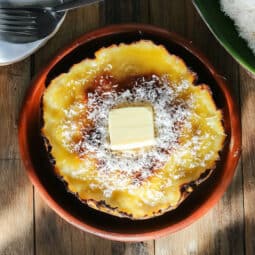
Bibingka Recipe (Traditional Filipino Christmas Rice Cake)
Bibingka is a beloved Filipino rice cake traditionally served during the Christmas season, particularly during Simbang Gabi (Misa de Gallo). This treasured delicacy features a soft, slightly sweet rice cake topped with salted eggs and cheese, finished with a generous sprinkling of grated coconut.Cultural Significance Bibingka is more than just a rice cake; it's a cherished part of Filipino Christmas traditions, symbolizing community, celebration, and the warmth of the holiday season. Traditionally sold outside churches during Simbang Gabi, its aroma and taste have become synonymous with Filipino Christmas celebrations.
Equipment
- Mamon tins or 6-inch round cake pans
- Banana leaves (dahon ng saging) or parchment paper
- Large mixing bowls
- Whisk
- Measuring cups and spoons
- Oven
- Baking sheet
- Kitchen scissors
- Tongs (for banana leaves)
Ingredients
For the Batter (Para sa Pinalamang)
- 2 cups rice flour
- ½ cup glutinous rice flour malagkit na bigas
- 1 cup sugar asukal
- 1 tablespoon baking powder
- 1 teaspoon salt asin
- 1½ cups coconut milk gata
- ½ cup water tubig
- 3 eggs beaten (itlog)
- ¼ cup melted butter tinunaw na mantikilya
For Toppings (Para sa Toppings)
- 2 salted eggs sliced (itlog na maalat)
- 2 ounces cream cheese or kesong puti
- Softened butter or margarine
- Sugar for sprinkling
- Fresh grated coconut niyog
Instructions
- Start this recipe the day before you plan to serve. Begin by gathering all your ingredients and ensuring they are at room temperature.
- The night before, combine 2 cups of rice flour (galapong), ½ cup glutinous rice flour (malagkit na bigas), 1 cup sugar (asukal), 1 tablespoon baking powder (pampalaki), and 1 teaspoon salt (asin) in a large mixing bowl. Whisk these dry ingredients together until well combined (haluing mabuti hanggang maghalo).
- Pour in 1½ cups coconut milk (gata) and ½ cup water (tubig) gradually while whisking continuously. Add ¼ cup melted butter (tinunaw na mantikilya) and 3 beaten eggs (binateng itlog). Mix thoroughly until you achieve a smooth, lump-free batter (hanggang maging makinis ang palaman). Cover the bowl with plastic wrap and refrigerate overnight or for at least 8-12 hours (ilagay sa refrigerator magdamag).
- The next day, start by preheating your oven to 375°F (190°C). While the oven heats, prepare your banana leaves (dahon ng saging). Clean them thoroughly with warm water and cut them into circles slightly larger than your baking molds. Pass each leaf quickly over an open flame for 2-3 seconds per side to make them pliable. This process releases the natural oils and aroma of the leaves.
- Line your mamon tins or 6-inch round cake pans with the prepared banana leaves, ensuring the shiny side faces up (ang makintab na parte ay nakaharap sa itaas). If using parchment paper instead, grease it lightly with butter.
- Remove the batter from the refrigerator and stir gently to recombine any separated ingredients (haluing muli ng marahan). Pour the batter into your lined molds, filling each about ¾ full. Place slices of salted egg (itlog na maalat) and pieces of kesong puti or cream cheese on top of each bibingka.
- Place the filled molds on the lower rack of your preheated oven and bake for 20-25 minutes. Watch as the edges begin to set and the center starts to rise. The batter should be mostly cooked through but still slightly wet on top.
- Move the bibingka to the top rack and switch your oven to broil at 450°F (230°C). Cook for an additional 1-2 minutes, watching carefully until the top develops beautiful char marks (hanggang magkaroon ng magandang tutong sa ibabaw). The top should have golden-brown spots but not be burnt.
- Remove from the oven and immediately brush the top with softened butter (pahiran ng malambot na mantikilya). Sprinkle generously with sugar (asukal) and top with freshly grated coconut (bagong kudkod na niyog).
- Serve your bibingka hot, straight from the oven (ihain habang mainit pa). The texture should be soft and fluffy in the center with a slightly crispy top and bottom. Traditional accompaniments include hot chocolate (tsokolate) or ginger tea (salabat).
- If you need to store leftover bibingka, let it cool completely then place in an airtight container. It will keep at room temperature for up to 24 hours or in the refrigerator for up to 3 days. To reheat, warm in a 350°F (175°C) oven for 5-7 minutes or microwave for 20-30 seconds, though oven reheating will better preserve the texture.
- Remember that bibingka is best enjoyed fresh and warm, when the contrast between the soft center and slightly crispy exterior is at its peak. The aroma of the banana leaves, coconut, and charred top creates that distinctive bibingka experience that makes it such a beloved Filipino Christmas tradition.
Tips from Lola's Kitchen
- Galapong substitute: For authentic texture, soak regular rice flour mixture overnight
- Banana leaf tip: If leaves break, double-layer them to prevent leaks
- Temperature matters: All ingredients should be at room temperature
- Even baking: Rotate pans halfway through baking
- Coconut freshness: Grate coconut just before serving
Nutrition
Calories: 352kcalCarbohydrates: 59gProtein: 6gFat: 11gSaturated Fat: 9gPolyunsaturated Fat: 1gMonounsaturated Fat: 1gTrans Fat: 0.01gCholesterol: 62mgSodium: 232mgPotassium: 156mgFiber: 1gSugar: 25gVitamin A: 90IUVitamin C: 0.4mgCalcium: 111mgIron: 2mg
Tried this recipe?Let us know how it was!